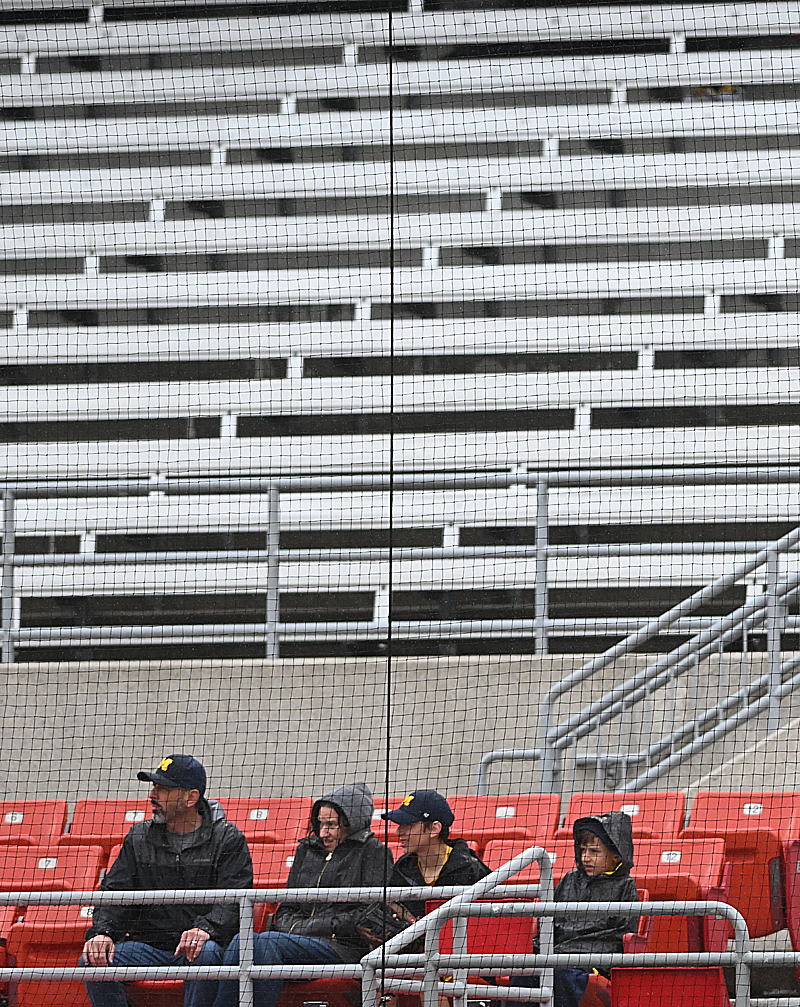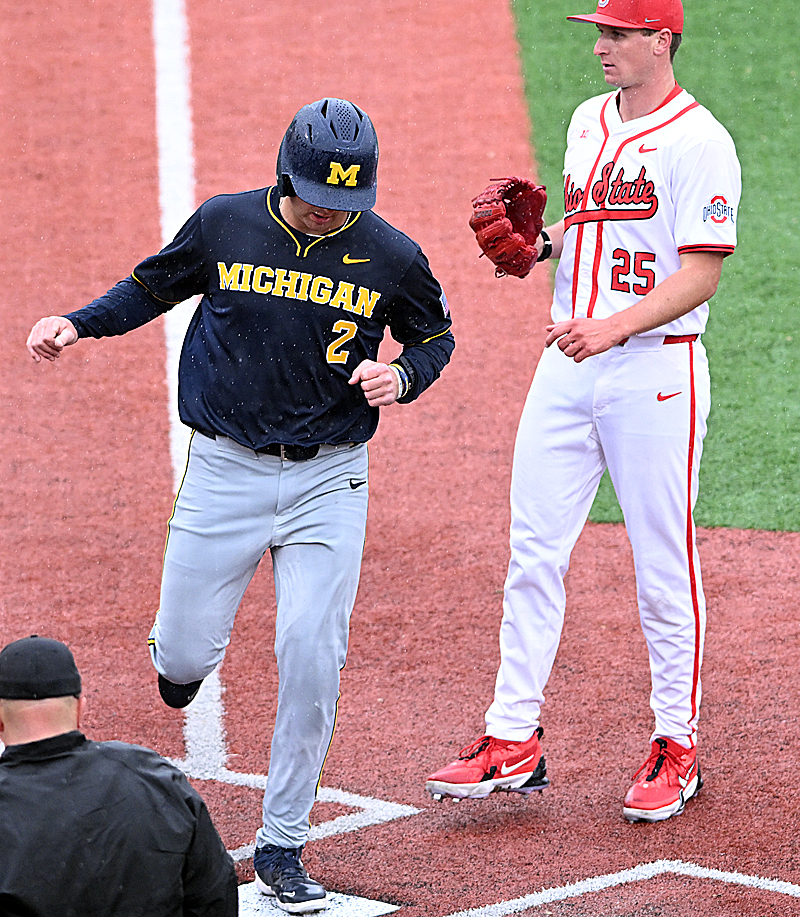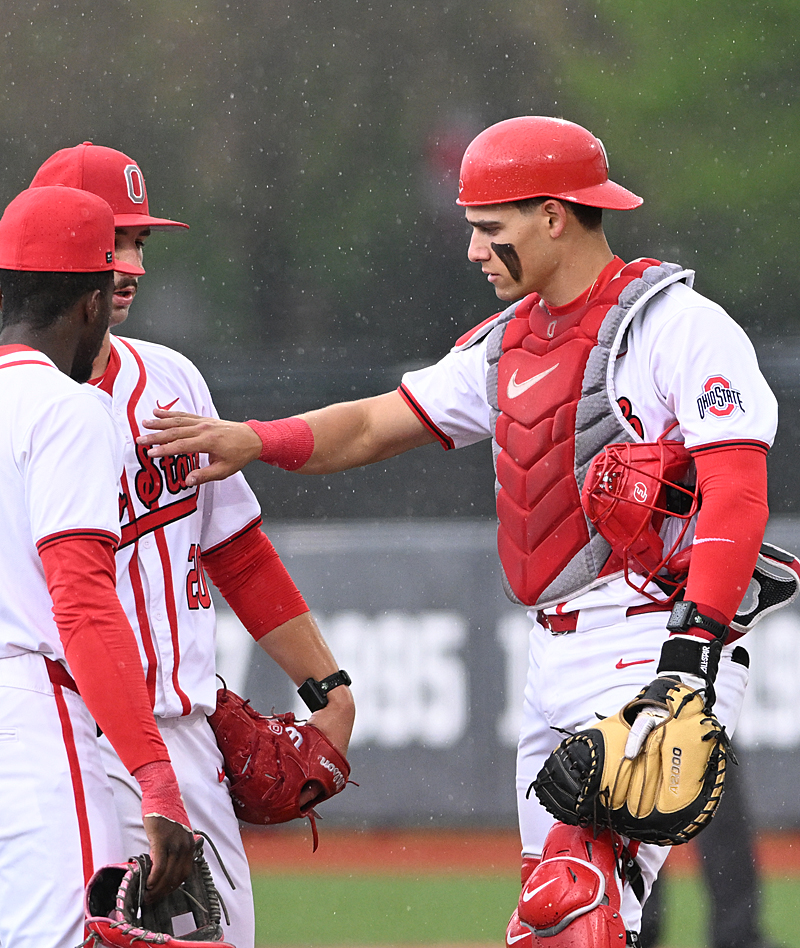
The Uecker family had front row seats. The rest wisely chose to come in out of the rain. (Press Pros Feature Photos)
Amidst an embarrassing loss and a highly questionable decision to play, Michigan’s 23-1 win in the first game of Saturday’s doubleheader raises another, more troubling question about the priority of NCAA baseball.
 Columbus, OH – If there was ever a question about the priority of baseball in the pecking order of the NCAA and Big Ten Conference sports prior to Saturday, let’s shed some light on it once and for all.
Columbus, OH – If there was ever a question about the priority of baseball in the pecking order of the NCAA and Big Ten Conference sports prior to Saturday, let’s shed some light on it once and for all.
In a game started in gathering rain, with forecasts of more rain to come over the course of the day, Michigan beat Ohio State 23-1 in a run-ruled verdict called after seven innings.
And while it’s true that both teams had to play in the rain, there is, nonetheless, the question of, “How much rain?” And for how long?
Which raises yet another, important question. Where were the umpires,the ones in charge of determining safe playing conditions for both teams? They make about $1,200 a game, and for more than strict adherence to a 17-inch pentagon made of rubber.
Run-rule is one thing. It’s quite another to call the game official after five innings due to inclimate conditions.
 For while much has been written about the youth and inexperience (and injuries) that have characterized Ohio State’s pitching staff in 2025, playing in rain heavy enough to create standing water on the crushed-brick outfield warning track, borders on another current issue common with cultural lip service. That being, how serious are we, really, about safety for athletes?
For while much has been written about the youth and inexperience (and injuries) that have characterized Ohio State’s pitching staff in 2025, playing in rain heavy enough to create standing water on the crushed-brick outfield warning track, borders on another current issue common with cultural lip service. That being, how serious are we, really, about safety for athletes?
As for the game itself, credit Ohio State starting pitcher Drew Erdmann (0-7) for giving it the old college try. He held Michigan to 2 runs on three hits for the first three innings.
But in the fourth the roof (or the skies), literally fell in on him.
He started the inning by hitting a pair of Michigan hitters, then a base hit to load the bases, then another walk to force in a run, along with his departure in favor of reliever Doug Bauer.

Six wild pitches helped account for 16 Michigan runs scored in the fourth inning.
Bauer would respond in the steady rain to record one out…and over the course of facing five hitters he allowed 4 runs on no hits, hit a batter, and walked three. He was taken down for reliever Luke Carrell.
Carrell would end up allowing four Michigan runs on 1 hit, a walk, two hit batsmen, and two wild pitches. He would be relieved, without recording an out, by freshman Tanis Lange,
Lange will for a long time be remembered for the oft-heard utterance, “taking one for the team”. Because in the course of his 3.1 innings of work he would allow 10 runs (5 in the fourth inning), 7 hits, 5 walks, 2 hit batters, and 6 wild pitches. Michigan would end up sending twenty one hitters to the plate in the fourth, yet Lange would end up finishing the game.
“Credit to Tanis for having to bleed for us right there,” said Justin Haire. “I praised him in front of our team, and I know the stat line wasn’t pretty…but he kept taking the ball and going out there, and found a way to throw it over that white thing. I was proud of him for doing that.”
Ohio State would score its lone run off Michigan’s bullpen in the bottom of the sixth on a walk, a base hit by Matt Graveline, and a RBI fielder’s choice by Mason Eckelman.
The final lines….
Michigan had 23 runs on 13 hits and left nine on base.
Ohio State fell to 11-31 (3-19 in Big Ten) with 1 run on 4 hits, leaving 7 on base. Buckeye pitchers would finish with 8 wild pitches, and 13 walks for the game, and while control has been an issue throughout the season, there’s no question that pitching in a steady rain exacerbated that one particular stat on Saturday.

Buckeyes catcher adds encouragement to starter Drew Erdman as the rain increased during the 16-run fourth inning.
Post-game, Justin Haire was exceedingly careful with his remarks about what 100,000 people would have asked had they been there to see it for themselves. Why was the game allowed to have gone as far as it did? And why were the umpires not more conscious of playing conditions and the safety of the players…both teams?
“I think the thinking was if we can get in at least one game today,” he answered. “They (the umpires) decided to battle through the weather and I thought it got pretty spotty there in the fourth and fifth innings. They tried to manage it the best they could, they made the decision. But we got started, and we’ll try to do better with it tomorrow.”
And yes, it does raise a question over priorities, and one athlete’s chance to compete safely in his chosen sport as compared to others in different sports. In this day, safety has been made the byword of contemporary baseball. And no one should have been asked to play in Saturday’s conditions, regardless of the score.

“Tough conditions,” said OSU’s Justin Haire on Saturday’s loss. “The umpires tried to manage it the best they could. They made the decision.”
“Yeah, tough conditions. There’s no doubt about it,” Haire added, straining to be as diplomatic as possible. “I’m not going to jump into all that, of course, but it was tough, yes.”
And his reticence is understandable. But still, it doesn’t mean that things don’t deserve to be questioned. Because you would not ask basketball to play outside during the middle of a January snowstorm. One could make a strong case Saturday for that comparison.
The series will resume on Sunday with the would-have-been doubleheader rescheduled to begin at noon. Starting pitching will be somewhat of a question due to the Buckeyes’ arms being banged up, by Haire’s own admission, but the expected starters will be Gavin Kuzniewski (3-4) and Jake Michalak (1-4).
And if you’re wondering…the forecast is for heavier rain in the morning, tapering to showers in the afternoon. That’s the forecast for weather.
The forecast for better judgment…is anybody’s guess.

The Hughes Law office, in Urbana, is the presenting sponsor for all OHSAA state tournament coverage on Press Pros. Call them today if they can help you…Ph. 937-398-0520


